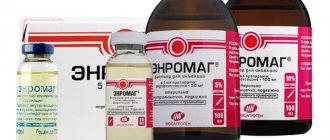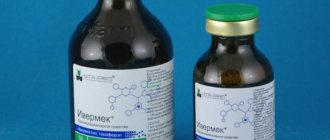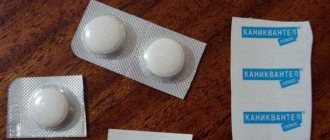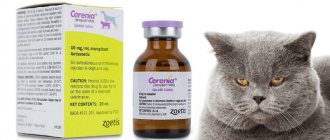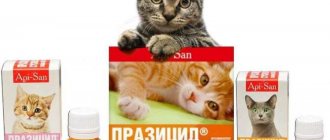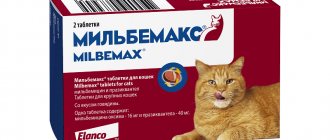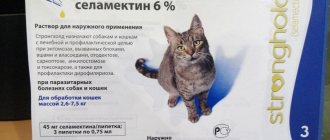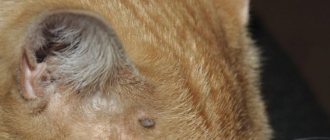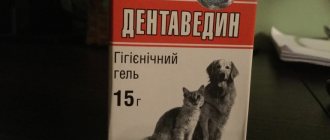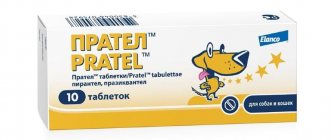Description of the drug Baytril
Baytril is an antibacterial drug that is widely used in veterinary medicine. The formula of this antibiotic was developed by German scientists, and it is produced by Bayer, but the medicine is presented by the Gold Line company. This is understandable: the manufacturer has many areas of work, and there are representative offices and branches in many countries around the world.
Baytril is produced by Bayer
We can say that the history of the Bayer concern is closely connected with Russian veterinary medicine. Like many modern drug manufacturers, Bayer began by making chemical dyes. The first such factory in Russia was opened back in 1876. In those days, exports and imports were subject to high duties, so in order to provide the entire Russian market with a “hot commodity”, the company had to expand. The official representation was headed by Vladimir Stolyarov (1883). Production gradually expanded (thanks to German creditors), and already in 1897 the Friedr company was established in Moscow. Bayer&Co.
Pharmaceutical products began to be produced in 1912. The plant occupied second place in the world market for the production of drugs (US factories were the leader). True, after a sharp breakthrough in this area, the factory had a hard time. Here the First World War played a role - the factory had to close for 2 years. And then the second war came, complicating economic relations between the countries. Work was restored only in 1978, and in 2012, the well-promoted Bayer HealthCare concern entered into a cooperation agreement with the Russian company. Partners are interested not only in the production and sale of goods, but also in conducting various scientific research, as well as in the development and promotion of innovative drugs.
At the moment, Bayer produces many popular veterinary drugs in Russia (remedies for ecto- and endoparasites, ticks, fleas, as well as antibiotics). One such antibiotic is Baytril.
The top photo shows the first chemical factory opened in Moscow, and the bottom photo shows the design of a modern plant
Composition of the drug
The veterinary drug is available in several versions, but Baytril 2.5% is used to treat cats. The composition of the medicine may not be indicated on the packaging, so cat owners should purchase this antibiotic with caution. It is important not to make a mistake with the concentration, since using the drug with a concentration of 5% and 10% can be dangerous for the animal.
The composition of 1 milliliter of the antibiotic Baytril includes the following components:
- enrofloxacin - 25 mg (active ingredient);
- butyl alcohol - 30 mg;
- potassium oxide hydrate - 3.94 mg;
- water for injection - up to 1 ml.
You only need to buy Baytril that says “2.5%” on the packaging.
Release form of the drug
The dosage form of Baytril is a sterile transparent solution for injection. The solution has a light yellow tint, but this is not visible in the packaging, since the drug is packaged in brown glass bottles. Each bottle is sealed with a special cap and packed in a cardboard box.
Important: both the bottle and the box indicate the concentration of the drug, the active ingredient, the volume and form of the drug. In addition, any package of Baytril must have the logo of the developer company (vertical and horizontal inscriptions - Bayer, which are crossed with each other). There is also a branded design on the box and label (blue and green arcs on a white and blue background).
Inside the box there are instructions for use, but not every pharmacy will allow you to take it out and study it. I have to buy veterinary drugs in two places. A pet store nearby is open 24 hours a day, but does not always have the medicine you need. And if the drug is still available, the seller allows you to look at the instructions. But you have to drive (2 stops) to the pet pharmacy, located in the veterinary clinic, but it is only open until 18:00. The drugs that I buy there are a little more expensive, and their packages are sealed with a holographic sticker so that when opened, the integrity will be compromised. In both cases, this is a genuine drug, which one you come across is a matter of chance.
Before purchasing an antibiotic, you need to pay attention to its packaging.
Storage conditions for the veterinary drug Baytril 2.5%
Like other medications, Baytril should be stored in closed containers. The bottle, sealed with a cap, should be stored in a place that small children or pets cannot reach. The best place to store the drug is a special first aid kit. The first aid kit should be kept away from food and animal feed. It is also important to prevent direct sunlight from coming into contact with the medicine cabinet.
The optimal temperature for storing Baytril is from 5 °C to 25 °C. If all conditions are met, the antibiotic will be valid for 3 years after the production date (indicated on the packaging). The medicine can be stored in an opened bottle for no more than 28 days.
If the expiration date has expired, the drug cannot be used. A bottle with an expired antibiotic should be disposed of with household waste (throw away). The same fate should befall a bottle of medicine that was not stored in accordance with the manufacturer's instructions. The fact that the drug has definitely deteriorated will be indicated by the quality of the solution (it may become dark, cloudy or with sediment), the appearance of the packaging (the box and/or label on the bottles may fade or turn yellow, which means they have been exposed to sunlight), etc. .
If you lose the insert, the storage conditions for Baytril are indicated on the side wall of the box
Warnings
Baytril is for use in animals only. In rare cases, use of this product in cats has been associated with retinal damage. Do not exceed 5 mg/kg body weight per day in cats. The safety of Baytril in breeding or pregnant cats has not been established. According to the instructions for use, keep out of the reach of children.
Avoid contact of Baytril solution with eyes. If contact occurs, immediately flush eyes with plenty of water for 15 minutes. In case of contact with skin, wash skin with soap and water. Consult a physician if irritation persists after exposure to eyes or skin. People with a history of hypersensitivity to quinolones should avoid contact with this product. People are at risk of photosensitivity within a few hours of excessive exposure to quinolones. In case of excessive accidental exposure, avoid direct sunlight.
Indications for use and pharmacological action
Indications for use may be the presence of one of the following diseases:
- diseases of the respiratory system (runny nose, rhinotracheitis, etc.);
- disturbances in the gastrointestinal tract (diseases of the stomach and intestines);
- diseases of the genitourinary system (cystitis, urolithiasis, etc.);
- infectious diseases of the skin;
- septicemia (blood poisoning due to another disease);
- colibacillosis (a serious disease, the main symptom of which is profuse diarrhea; it can lead to dehydration and death of the animal);
- salmonellosis (an acute intestinal infection that leads to intoxication and dehydration);
- streptococcosis (leads to damage to the respiratory and digestive organs, joints, etc.);
- mixed infections;
- secondary infections in viral diseases;
- prevention of inflammation after sterilization/castration.
In other words, Baytril can be prescribed for any disease if its causative agent is sensitive to erofloxacin. Therefore, an important point is to identify the pathogen and diagnose the disease.
To prescribe Baytril, we took a urine test specifically for bacterial culture. I took a fresh test from the clinic to Moscow. Gate to the city veterinary laboratory (so that no more than 2 hours pass). Based on the results of the analysis, this particular antibiotic was selected.
mar_ina_hvost, forum user
https://www.vsehvosty.ru/forum/viewtopic.php?t=127658
Photo gallery: pathogens of infectious diseases sensitive to Baytril
The bacterium Bordetella pertussis (also known as whooping cough) causes damage to the epithelial tissue of the lungs
Mycoplasma spp. affects the genitourinary organs
Salmonella usually affects the stomach wall or small intestine
Staphylococcus can cause many different diseases, depending on the strain of the bacterium
The bacterium Streptococcus is the causative agent of pneumonia
Baytril 2.5% promotes the production of an enzyme that can penetrate the cells of pathogenic bacteria. This enzyme is able to influence the DNA of bacteria and destroy it from the inside. This effect of the drug begins as soon as the antibiotic reaches its maximum concentration in the blood (30 minutes after administration). After this, the active substance “works” for another whole day and only then is eliminated from the body naturally.
For what diseases is it prescribed?
The medication is recommended for the following pathological conditions:
- acute respiratory infections and other diseases of the upper respiratory tract;
- gastrointestinal pathologies caused by bacteria;
- intestinal infections caused by salmonella, streptococci;
- Eschirichiosis;
- after surgical interventions;
- toxic form of sepsis;
- diseases of the urinary system;
- mixed infections.
Injection to a cat
The medication is also prescribed for secondary infection, pustular lesions, purulent tissue inflammation and other pathological conditions that are caused by this provoking agent.
Not prescribed for:
- gestation, feeding newborns;
- under 1 year of age;
- convulsive states;
- diseases of the musculoskeletal system.
Features of using Baytril for the treatment of cats
The big problem for inexperienced cat breeders is that they search the Internet for general information about Baytril drugs. This usually leads to improper use of the medicine, which, in turn, affects the health of the pet. For example, Baytril 5% is intended for treating other animals, but the cat owner believes that the solution can simply be diluted, for example, with saline in a 1:1 ratio. Subsequently, the animal’s condition will only worsen. Therefore, if you are not sure that you have made the right choice, contact your veterinarian. In any case, self-medication may not end well.
Baytril is usually given to cats as a subcutaneous injection. The neck area (between the shoulder blades) is ideal for this. A veterinarian I know told me a story about a new breeder who gave her cat an intramuscular injection. Allegedly, there were sores on the animal’s back (in fact, an antibiotic was prescribed because of this disease), so the woman “felt sorry” for the cat and decided to give it an intramuscular injection. Of course, there were consequences. It turns out that Baytril is a very painful injection, so injection into the muscle leads to pain and numbness in the limb.
A hypodermic injection of a cat can be given in the withers or in the knee fold, but it is more convenient to use the withers (the needle must be inserted at an angle of 90 degrees to the skin to a depth of no more than 1 cm)
Selection of antibiotic dosage
No matter how contradictory the dosages offered on the Internet may be, the manufacturer recommends a clear formula - 0.2 ml of the antibiotic Baytril 2.5% subcutaneously per 1 kg of cat’s body weight. If we are talking about home treatment, then you first need to measure the cat's weight. For example, you can first weigh yourself on a scale, and then weigh yourself with your cat. The difference is the weight of the animal.
Only a veterinarian can correctly adjust the daily dosage. Again, various forum users, only out of good intentions, advise repeating their experience and injecting the cat, for example, with a double dose. An ignorant cat breeder will buy a solution of the wrong concentration (for example, 5%), and even administer a double or even triple dose. This can result in dire consequences. And an inattentive person without experience can draw not 0.2 ml, but 2 ml into a syringe. And this is already a tenfold increase. Therefore, either 0.2 ml per day, or go to the veterinarian.
For feline urolithiasis, 4% gentamicin solution - 0.4 ml/bird, s.c., 1 time per day, for 7 days 2.5% baytril solution - 0.4 ml/kg, s.c. or i.m. , once a day, for 5 days
Khodova Yulia Sergeevna, Candidate of Veterinary Sciences
https://medical-diss.com/veterinariya/farmakologicheskoe-obosnovanie-kompleksnogo-lecheniya-kotov-bolnyh-urolitiazom
It is extremely important not to exceed the recommended dosage of Baytril 2.5%
Cat treatment plan
The manufacturer indicates that treatment with this antibiotic can last up to 3 to 10 days. Veterinarians most often prescribe Baytril injections for 5 days. If the disease is complicated and difficult to treat, then the veterinarian can extend the course to 10 days (but this does not always happen). If during the first 5 days there is no improvement in the cat’s condition, the veterinarian may discontinue this remedy and prescribe another one instead. It is not advisable to stop taking antibiotics on your own. Since enrofloxacin has a very powerful effect on harmful bacteria. Without an antibiotic, the disease will begin to progress, because you have already started using it.
Usually Baytril injection is given once a day, but sometimes veterinarians change this regimen if, for example, the dose is too large at one time. In such cases, the single dosage is divided into several parts - 2 or 3 times a day.
You cannot do the following:
- if one day is missed in the schedule of prescribed injections, there is no need to administer a double dose the next day;
- if you yourself replace Baytril with another antibiotic, immediately notify your veterinarian;
- It is advisable to treat the cat with the same veterinarian, since a permanent doctor monitors the healing process.
Some owners, in the absence of positive dynamics, begin to panic and look for another specialist (because this one “does not know how to treat”), but this is one of the common mistakes. The fact is that the veterinarian who prescribed the antibiotic monitors all indicators. In addition, you simply will not be able to see some changes in your pet’s health (for example, the number of white blood cells in the blood). Each veterinarian has his own tactics, proven skills and experience in treating such diseases. If you move from one veterinarian to another, then all observations made during the use of Baytril will be lost.
The course of using Baytril 2.5% can last up to 10 days
Precautions when working with the drug
The instructions do not indicate any special precautions when working with Baytril. General rules must be followed:
- Before working with the drug, you need to wash your hands with soap;
- the syringe must be sterile (freshly unpacked);
- the injection can be done with gloves;
- especially suspicious cat owners (as well as those who are sick) can use a medical mask;
- After the injection, it is recommended to wash your hands and face with running water;
- if the drug gets on the mucous membranes or skin, the place where the drug came into contact should be washed;
- if the cat owner develops an allergy to the drug, contact a medical facility;
- The used disposable syringe (as well as the capped needle) must be thrown into the trash.
The GOST standard 12.1.007–76 classifies Baytril 2.5% as hazard class 3 (moderately hazardous substances). Therefore, when using this antibiotic, you do not need to kick family members out into the street, and you do not need to put a gas mask on your head. However, general safety rules must be followed. It is also important that the veterinarian does not ignore them.
I don’t know how to prick, and as a result I pierced my cat’s skin and my friend’s finger. Everyone survived. The only thing that could happen, in my opinion, is a local reaction to the drug you injected, but the likelihood of this is very low, since the drug is intended specifically for injection. I had a case when I fed a cat “CatErvin”, and in order to accurately measure it, I drew the infusion from the bottle with a syringe. The needle somehow fell off and I pierced my finger. The finger immediately swollen and did not bend well for 3 days, then everything went away, apparently it was an allergy to the drug that remained on the tip of the needle.
T_Anja, forum user
https://mauforum.ru/viewtopic.php?f=36&t=4304&start=20&view=print
Standard precautions - medical mask and rubber gloves
Features of use in pregnant cats and kittens
The official instructions for the use of Baytril 2.5% indicate that it does not have an embryotoxic effect. However, it is not recommended for use in pregnant cats. You should also stop using antibiotics when treating lactating females. If you are unsure, but suspect your cat is pregnant, and the veterinarian prescribes Baytril, then tell him about your guesses. The veterinarian may prescribe another drug that is safe for the expectant mother.
Baytril is not prescribed to small kittens. A specific age for such a restriction is not specified, but veterinarians attribute this specifically to the growth of the animal. The fact is that an antibiotic based on enrofloxacin can affect the growth and development of the animal. Therefore, this medicine is recommended to be used to treat those kittens that have already achieved the appearance of an adult, even if they are under 1 year of age.
A breeder I know treated the entire litter for rhinotracheitis. The kittens were not even six months old. The veterinarian prescribed Baytril, but warned the owner about all the possible consequences. The kids were in poor condition, and there was simply no time to try a “gentler” medicine. Fortunately, the kittens were cured. Now they are not yet a year old, but they have grown into beautiful cats and cats. So there are two options here. The first is that a cat breeder can trust a specialist and risk the kitten’s growth in favor of preserving its life. The second is to give up the powerful antibiotic so that the baby has a chance to grow up. But in the second case, the cat may not recover.
Baytril is not recommended for the treatment of cats during pregnancy and lactation, and the manufacturer does not recommend treating kittens with this drug during the growth period
Interaction with other drugs
All antibiotics are prescribed in combination with other drugs, for example, whose action is aimed at symptomatic therapy. But Baytril 2.5 cannot be combined with the following medications:
- tetracycline antibiotics;
- Theophylline;
- Levomycetin;
- anti-inflammatory non-steroidal drugs.
A veterinarian I know told me how a cat with an unknown disease was brought to his appointment. The cat's owners became suspicious when the first veterinarian tried to make a diagnosis without any tests. They were prescribed treatment on the first day of treatment. The list of recommendations included both Baytril 2.5 and Rimadyl. Of course, the vigilant owners decided to play it safe. And it turned out that it was not in vain. The fact is that Rimadyl is a non-steroidal anti-inflammatory drug. Its combined use with Baytril can lead to unpredictable results.
Here is an approximate treatment regimen for rhinotracheitis in a cat, which a veterinarian can prescribe:
- antibiotic: Baytril 2.5;
- immunocorrective agent: for example, Fosprenil;
- vitamins: B12 and B6 - are administered separately, as well as vitamin C;
- eye drops, etc.
Baytril can be combined with drugs prescribed for symptomatic treatment
Dosage for other animals
Depending on the size of the animal, the veterinarian may prescribe different concentrations of the drug. If you choose Baytril or Ciprofloxacin, the dosage for dogs is calculated in the usual way, based on weight (0.2 ml per kilogram), and the concentration depends on the size of the animal.
Dogs of medium and large breeds are prescribed a medicine with a concentration of the active substance of 5%. The dosage of antibiotics for dogs may vary depending on the situation. So, large animals are prescribed one milliliter per 20 kilograms of weight. It must be administered in the same way as cats, by subcutaneous injection into the neck area.
If you bought Tsiprolet, the dosage for dogs is calculated in the same way, except for cases of mastitis-metritis-agalactia syndrome in lactating bitches. In this case, treatment is carried out for 5 days, and the dosage of the drug is a milliliter per 10 kilograms of weight.
Pigs are prescribed Ciprofloxacin injections intramuscularly for various diseases. The concentration depends on the age of the animal, so large pigs are prescribed an injection solution with 10% active substances, and one-year-old animals are prescribed Enrofloxacin 5% (or its analogues), which is calculated according to the same scheme as for dogs. When the dosage of the active substance is 10%, the dose is calculated in a different way than in dogs - 2.5 ml per 100 kilograms of live weight.
Drinking Baytril (5) for birds is not administered by injection; instead, a small amount of the substance is introduced into the water located near the feeder. The dosage in this case can only be calculated by a veterinarian, since it depends on the number of poultry and its breed.
Possible side effects and contraindications
The manufacturer reports that if all recommendations in the instructions are strictly followed, no side effects will occur. In rare cases, there may be disturbances in the gastrointestinal tract (for example, diarrhea), but this quickly passes. The cat may also be allergic to one of the components of the drug. In this case, the use of Baytril is discontinued, and the cat is prescribed antihistamines (for example, Suprastin).
All problems associated with an undesirable effect usually arise due to improper use of the antibiotic (for example, violation of the dosage and treatment regimen). Some cat owners who treated their pets with this drug claim that the animal developed sores at the injection site. However, veterinarians attribute the formation of scabs not to a side effect of the drug, but to a violation of the instructions for use. There are people who advise everyone to inject intramuscularly, which goes against the manufacturer’s recommendation. And veterinary practice shows that intramuscular administration of the drug leads to numbness in the animal’s limbs.
Baytril, when injected incorrectly, kills hair follicles. Therefore, it is recommended to inject it intramuscularly (although in this case it can cause lameness, which, fortunately, passes).
Whisper, forum user
https://mauforum.ru/viewtopic.php?p=661879
Photo gallery: what does violating the instructions for use lead to?
If you violate the rules for administering the drug, an abscess or infiltrate may occur at the injection site.
After an incorrect injection (for example, with an overdose), the cat may scratch the injection site until the wound becomes bloody, and this can lead to severe infection, necrosis or sepsis
A painful intramuscular injection of an antibiotic can lead to temporary numbness in the limbs
In case of an overdose, the cat may show signs of anaphylactic shock: shortness of breath, wheezing, rapid breathing, protruding tongue, etc.
Once scabs form, your cat may have permanent bald spots.
Contraindications to the use of the antibiotic Baytril 2.5%:
- individual intolerance to the components of the drug by the cat;
- disorders of the development of cartilage tissue;
- diseases of the nervous system (for example, seizures);
- growth period in kittens;
- pregnancy and lactation in cats.
If the disease is caused by bacteria resistant to fluoroquinolones, then Baytril is also not prescribed (pointless). If it turns out that the cat is intolerant to the medicine, then analogues are not prescribed. The veterinarian should review the treatment regimen completely and choose an antibacterial agent of a different category, since analogues may contain the same active ingredient. To do this, you need to contact a veterinarian as soon as you suspect something is wrong (fever, the animal is not feeling well, an abscess is brewing at the injection site, etc.).
Be sure to show the withers to your doctor so that he can assess the condition of the tissues. Measure the cat's temperature - firstly, the episode of hyperthermia may recur, and secondly, if an abscess is brewing at the withers, the temperature may also rise.
Elena Kaurkina, forum visitor, veterinarian
https://www.zoovet.ru/forum/?tid=7&tem=952416
In some cases, drug intolerance is discovered only after starting its use.
DRUG INTERACTIONS
According to the instructions for use in veterinary medicine, compounds that contain metal cations (for example, aluminum, calcium, iron, magnesium) may reduce the absorption of certain drugs of the quinolone class from the intestinal tract of animals. Concomitant therapy with other drugs that are metabolized by the liver may decrease the rate of clearance of the quinolone and the other drug.
Dogs: Baytril was administered to dogs at a daily dose of 10 mg/kg concomitantly with a wide range of other medications, including anthelmintics (praziquantel, febantel, sodium disophenol), insecticides (fenthion, pyrethrins), heartworm preventatives (diethylcarbamazine), and other antibiotics ( ampicillin, gentamicin sulfate, penicillin, dihydrostreptomycin). Currently, there is no known incompatibility with other medicinal products.
Cats: Baytril was administered at a daily dose of 5 mg/kg simultaneously with anthelmintics (praziquantel, febantel), an insecticide (propoxur) and another antibacterial drug (ampicillin). Currently, there is no known incompatibility with other medicinal products.
Baytril analogues according to indications for use
The following antibiotics are analogues of the drug Baytril:
- Ciprofloxacin;
- Tsiprolet;
- Enromag;
- Quinokol;
- Enrosept;
- Enrofolks, etc.
Comparison table: Baytril analogues
| Name | Active substance | Release form | Price |
| Ciprofloxacin | ciprofloxacin |
| From 27 rubles for 10 tablets. |
| Ciprolet |
| From 60 rubles for 10 tablets. | |
| Enromag | enrofloxacin | Injection. | From 160 rubles per 100 ml. |
| Quinocoli | From 100 rubles per 100 ml. | ||
| Enrosept | From 50 rubles for 10 ml. |
Photo gallery: some analogues of Baytril
Injection solutions can be purchased in the form of single doses (some veterinarians dispense doses in disposable syringes according to the number of days of the course)
Tsiprolet is an analogue of ciproflorxacin, it can be bought at a veterinary pharmacy
Ciproflorxacin can be bought at any pharmacy; it is the cheapest analogue of Baytril
Enromag and Enrosept contain Enroflorxacin, therefore they are most similar to Baytril in their action
Enrosept is sold in convenient 10 ml bottles
Reviews
On various forums on the Internet you can find many reviews about the drug “Baytril” from both veterinarians and pet owners. There are both positive and negative opinions on treatment with this medicine.
Maria: “Our cat fell ill with pneumonia and we, like obedient patients, did everything the doctor said. This included injecting Baytril intramuscularly. We cured pneumonia, but the cat’s legs began to fail and there were bald spots in her fur. A very, very questionable drug!”
Dmitry: We treated a cat for rhinitis and cough. The veterinarian said that the disease was serious and that he needed antibiotics. After two uses, the cat’s health improved. I did not notice any unexpected reactions to the medicine. Only in the place where the injection was given there was apparently pain, since the cat did not allow itself to be stroked there and tried to move away.
